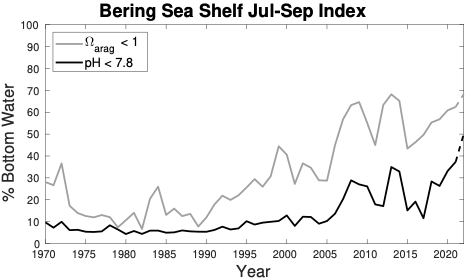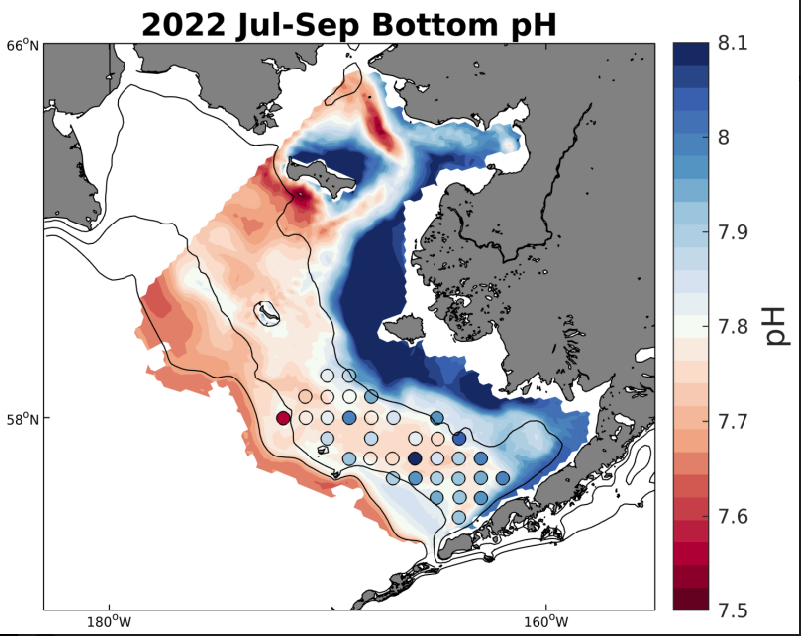 For the third year, ocean acidification was included in the Eastern Bering Sea Ecosystem Status Report (ESR) produced for the North Pacific Fishery Management Council. These annual reports are produced for each ocean basin and help fisheries managers track indicators important to fish populations. Ocean acidification appears in the “emerging issues” section of the report. (ESR, see page 164). This helps managers begin to learn about and factor in ocean acidification over time.
For the third year, ocean acidification was included in the Eastern Bering Sea Ecosystem Status Report (ESR) produced for the North Pacific Fishery Management Council. These annual reports are produced for each ocean basin and help fisheries managers track indicators important to fish populations. Ocean acidification appears in the “emerging issues” section of the report. (ESR, see page 164). This helps managers begin to learn about and factor in ocean acidification over time.
The Bering Sea is already naturally more corrosive than other regions of the global ocean because of its cold carbon-rich waters, making it more vulnerable to rapid changes in ocean chemistry. The projected expansion and shallowing of these corrosive waters due to ocean acidification pose a threat to marine organisms and fisheries, demonstrating a clear need to monitor and forecast the spatial extent of acidified waters.
Scientists at the Cooperative Institute for Climate, Ocean, and Ecosystem Studies and NOAA are generating model-based ocean acidification forecasts and hindcasts to help us understand current conditions and track change. These efforts focus on summer bottom waters because this is where the most acidic conditions are expected to develop (due to the combination of ocean acidification and natural seasonal biological respiration.) Summer is also when temperatures are close to their highest and are thus most likely to have synergistic negative effects on crab.
The information presented in the ESR include spatial plots showing the current summer’s bottom water conditions, and the anomaly after removing the slow, consistent ocean acidification trend. Removing this trend highlights the role of natural processes, which generate most of the year-to-year variability in the carbon system. An index is also presented showing the percent of total shelf bottom waters which are below thresholds that could impact species. This includes pH values ≤ 7.8 which negatively affects growth and survival of red king and tanner crab, and Ωarag < 1 which negatively affects bivalve larvae. The goal of the map and index are to provide a quick assessment of the summer water pH and Ωarag conditions compared to previous years. Developing these model products is an iterative process and researchers are continually working on improving model performance through comparisons with data collected in the Bering Sea.
Primary findings for 2022:
- Modeled bottom water pH and Ωarag were slightly lower (slightly more acidic/corrosive) than the 50 year average over most of the outer and middle shelf.
- A large geographic expanse included conditions harmful to key species. Around 50% of bottom water surpassed the thresholds favorable to red king and tanner crab growth, and around 70% of bottom water surpassed the threshold safe for bivalve larvae. For both indices, the amount of bottom water exceeding the thresholds in 2022 was the highest of any time over the model simulation period (1970-2022).
- Survey data from 2022 suggests that one of the largest coccolithophore blooms on record likely altered the surface and bottom carbonate chemistry. This illustrates the role of natural variability in carbon chemistry data.
The lead author of the OA section was Darren Pilcher at the University of Washington. Co-authors included NOAA researchers Darren Pilcher, Jessica Cross, Elizabeth Siddon, and W. Christopher Long, UAF researcher Natalie Monacci and UC Davis researcher Esther Kennedy.
Graphs

The graph at left shows the percent of bottom water exceeding thresholds harmful to marine organisms. The black line shows pH<7.8 (harmful to red king and tanner crab) and the gray line shows Ωarag <1 (harmful to bivalve larvae). The dashed portion at the end represents the incomplete 2022 value, which runs through September. The graph shows a larger percent of bottom water was harmful to marine species in 2022 than any other year in the time series.

The map at right shows modeled bottom water pH values. Areas of red indicate a pH above the threshold of 7.8 which is harmful to red king and tanner crab. Areas of blue are below the threshold. The circles represent the preliminary ship-based data collected in early September 2022, plotted on the same color bar as the model output. Waters closer to shore are more basic while outer waters are more acidic. The model time period is summer (July-early Sept).
Read the full 2022 Eastern Bering Sea Ecosystem Status Report (OA on page 164).
